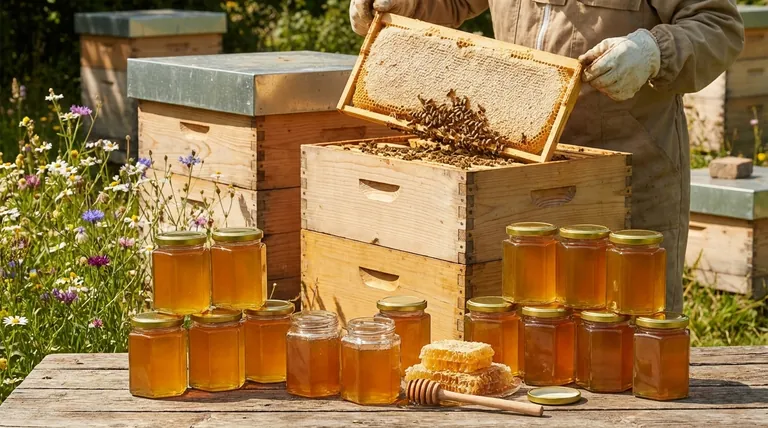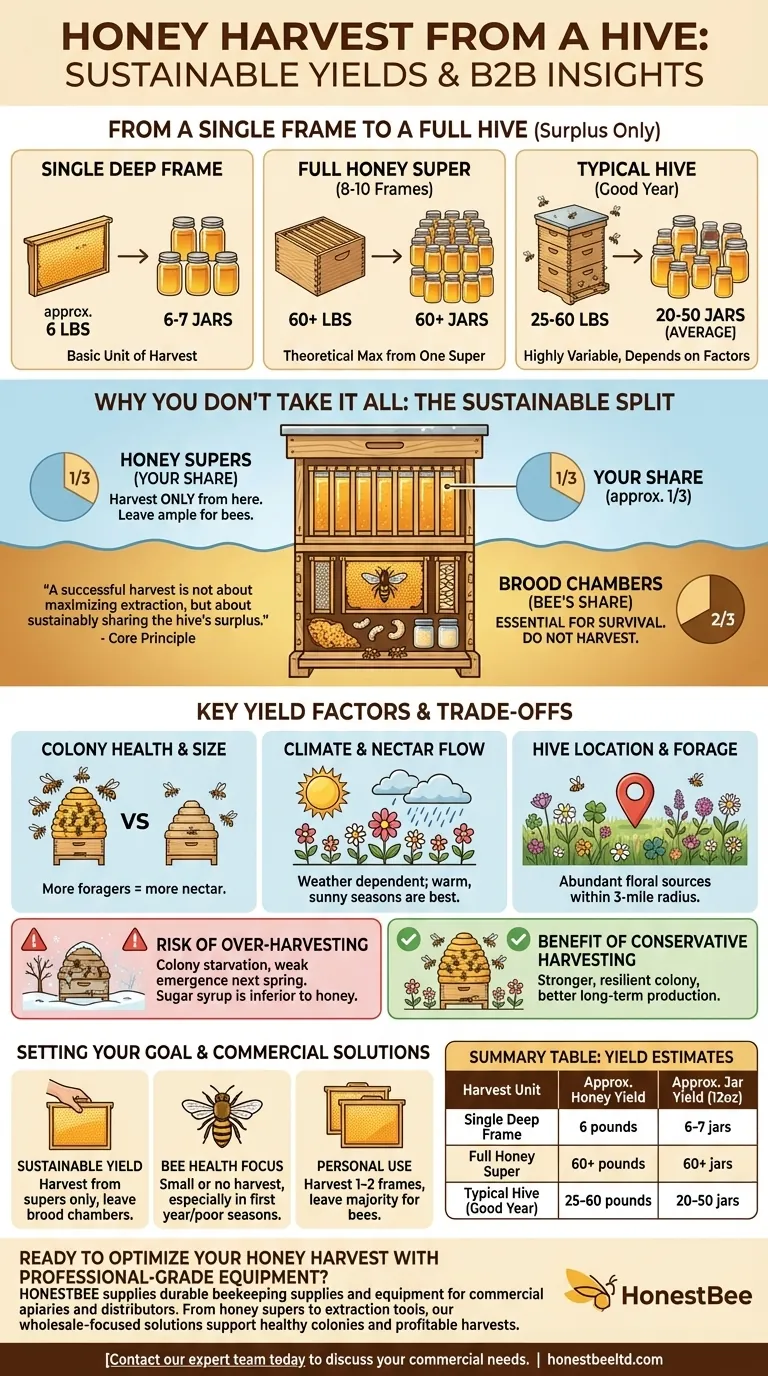The amount of honey you can harvest from a single hive is highly variable, but a common yield can range from 25 to 60 pounds (roughly 20 to 50 twelve-ounce jars) in a good year. Some beekeepers measure yield per frame, with a single deep frame producing around six to seven jars of honey. The most critical factor, however, is not the hive's total production, but the amount of surplus honey available after the bees' own needs are met.
A successful harvest is not about maximizing extraction, but about sustainably sharing the hive's surplus. The central principle is to always leave more than enough honey for the colony to survive and thrive through the winter.

From a Single Frame to a Full Hive
To understand honey yield, you must think in terms of the hive's components. A hive is not a single unit but a modular system of boxes, frames, and bees.
The Yield of a Single Frame
A single "frame"—the removable structure inside the hive where bees build comb and store honey—is the basic unit of a harvest.
As a general rule, one fully capped, deep frame of honey can yield approximately six pounds of honey, which fills about six or seven standard 12-ounce jars.
Scaling Up to a Hive
A modern beehive consists of multiple boxes stacked vertically. The bottom boxes, called brood chambers, are where the queen lays eggs and the colony raises its young. The honey here is essential for the bees' daily survival.
Beekeepers add upper boxes, called honey supers, specifically for the bees to store surplus honey. A single super typically contains 8 to 10 frames. Therefore, a full super can theoretically yield 60 or more jars of honey.
Why You Don't Take It All
A productive colony can produce over 100 pounds of honey in a season, but much of this is not surplus. The bees need this honey as their food source to survive the winter and fuel the next season's growth.
A core tenet of responsible beekeeping is to harvest only from the honey supers, leaving the brood chambers untouched. A common guideline is to take about one-third of the total honey produced, leaving the other two-thirds for the bees.
Key Factors That Determine Your Harvest
The "25 to 60 pound" average is just that—an average. Your actual harvest is dictated by several powerful environmental and management factors.
Colony Health and Size
A large, populous, and healthy colony has more forager bees. More foragers mean more nectar collected and more honey produced. A new or weak colony may not produce any surplus honey in its first year.
Local Climate and Nectar Flow
Honey production is entirely dependent on the weather. A warm, sunny season with adequate rain results in a strong "nectar flow," where flowers are producing abundant nectar. A cold, rainy spring can severely limit foraging time and drastically reduce or eliminate a honey harvest.
Hive Location and Forage
The quantity and quality of flowering plants within a bee's three-mile foraging radius is critical. A hive located near diverse and abundant sources of nectar—like fields of clover, orchards, or wildflower meadows—will be far more productive than one in an area with poor forage.
Understanding the Trade-offs: The Beekeeper's Pact
Every decision to harvest involves a critical trade-off between your desire for honey and the colony's need for survival.
The Risk of Over-harvesting
Taking too much honey, especially late in the season, is the most common and damaging mistake a new beekeeper can make. A colony without sufficient winter stores will starve.
While you can feed bees sugar syrup as a replacement, it lacks the complex micronutrients found in honey and is an inferior substitute for their natural food source.
The Benefit of Conservative Harvesting
Leaving ample honey ensures the colony is strong, well-fed, and resilient against disease and harsh weather. This approach often results in a more robust colony that emerges stronger the following spring, leading to better honey production in the long run.
Some beekeeping systems, like the Flow Hive, make it easy to harvest just a small amount at a time—even a single frame—allowing you to enjoy a taste while leaving the vast majority for the bees.
Setting Your Realistic Harvest Goal
Your approach to harvesting should align with your primary goal as a beekeeper.
- If your primary focus is a sustainable honey yield: Plan to harvest only from dedicated honey supers and always leave the brood chambers untouched for the bees.
- If your primary focus is bee health and colony resilience: Be prepared to take a very small harvest, or even no harvest at all, especially in the hive's first year or during a poor season.
- If your primary focus is a small harvest for personal use: Adopt the strategy of harvesting just one or two frames at a time, ensuring the majority of resources always remains with the colony.
Ultimately, a successful beekeeper measures success not just in jars of honey, but in the continued strength and health of their hives.
Summary Table:
| Harvest Unit | Approximate Honey Yield | Approximate Jar Yield (12oz) |
|---|---|---|
| Single Deep Frame | 6 pounds | 6-7 jars |
| Full Honey Super (8-10 frames) | 60+ pounds | 60+ jars |
| Typical Hive (Good Year) | 25-60 pounds | 20-50 jars |
Ready to optimize your honey harvest with professional-grade equipment?
As a commercial beekeeper or distributor, maximizing your sustainable yield requires reliable, efficient tools. HONESTBEE supplies the durable beekeeping supplies and equipment that commercial apiaries and distributors trust for large-scale operations. From honey supers to extraction tools, our wholesale-focused solutions are designed to support healthy colonies and profitable harvests.
Contact our expert team today to discuss your commercial beekeeping equipment needs and discover how we can help you build a more resilient and productive operation.
Visual Guide

Related Products
- Hexagonal Glass Honey Jars with Metal Lug Caps Elegant Versatile Packaging
- Inverted Squeezable Honey Jar with No Drip Flip Top Cap for Easy Pouring
- Premium Diamond-Faceted Glass Honey Dispenser
- Professional Cone-Shaped Honey Filter with Reinforced Steel Ring
- Natural Wood Honey Dipper for Tea Coffee and Desserts
People Also Ask
- What is the term for honey can absorb moisture from the air? Understanding Hygroscopy
- What factors should be considered when choosing honey packaging? Optimize for Brand, Operations & Market
- What is done with the honey after extraction and filtering? From Purification to Perfect Packaging
- Why is a glass jar preferred for packaging honey? Ultimate Protection for Purity & Flavor
- How should honey be stored and packaged? Preserve Flavor & Quality with Proper Containers



















